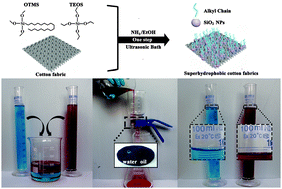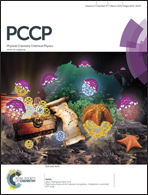One-step fabrication of robust fabrics with both-faced superhydrophobicity for the separation and capture of oil from water†
Abstract
In this work, a facile and inexpensive one-step sonochemistry irradiation method was developed for the fabrication of SiO2 nanoparticles functionalized with octadecyltrimethoxysilane and their in situ incorporation into cotton fabrics. The double sides of as-prepared fabrics show both superhydrophobic and superoleophilic properties simultaneously with a high water contact angle of 159 ± 1° and an oil contact angle of 0°. Thus, it can be used to separate and capture a series of oils from water, like kerosene, toluene and chloroform, etc. In addition, the as-prepared fabrics still have superhydrophobicity with a water contact angle of above 150° after 40 separation cycles with the separation efficiency for the kerosene–water mixture always above 94.6%. More importantly, the as-prepared fabrics showed robust and stable superhydrophobic properties towards hot water, many corrosive solutions (acidic, basic, salt liquids) and mechanical abrasion. Therefore, this reported fabric has the advantages of scalable fabrication, high separation efficiency, stable recyclability, and excellent durability, exhibiting the strong potential for industrial production.


 Please wait while we load your content...
Please wait while we load your content...